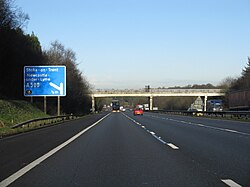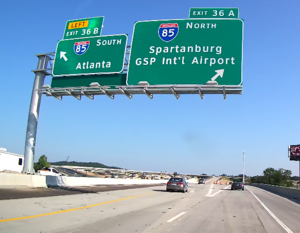Tag:highway=motorway_junction
 |
| Description |
|---|
| An exit from a motorway or other major road. |
| Rendering in OSM Carto |

|
| Group: highways |
| Used on these elements |
| Useful combination |
| See also |
| Status: de facto |
| Tools for this tag |
|
Use the highway=motorway_junction tag to identify a point along a highway=* with junction refs or names where it is possible to exit the highway onto another road.
This is usually found along a highway=motorway, but is also applicable to other major roads with numbered/named and typically grade-separated junctions, e.g. highway=trunk or highway=primary. Ordinary at-grade road junctions for local orientation only are generally mapped with junction=yes instead.
How to use
Add a highway=motorway_junction tag at each node ![]() along a highway with named or numbered junctions where a driver can legally exit, onto a
along a highway with named or numbered junctions where a driver can legally exit, onto a highway=motorway_link, highway=trunk_link or other road class. This node should be positioned as the last point before the splay at which it is still possible to make a smooth turn.
Name and number
Some countries name their motorway junctions (e.g. Italy), while others number them (e.g., UK, US,[1] Spain; also France for most motorway junctions), some are doing both (Germany, France for junctions with the circular motorway surrounding major cities).
The following tags may be added to the ![]()
highway=motorway_junction node:
ref=*to identify the![[W]](/w/images/2/24/Wikipedia-16px.png) exit number, as indicated on nearby signage. For unnumbered exits (e.g. to rest areas) in highway systems where exits are normally numbered, use
exit number, as indicated on nearby signage. For unnumbered exits (e.g. to rest areas) in highway systems where exits are normally numbered, use noref=yesto explicitly note that theref=*tag is not missing, but rather that no such value exists for that node.name=*for the name of the junction or interchange. Do not confuse the name of a junction with the destination(s) the junction leads to. In most cases worldwide, sign information describes destinations, not the name of the junction or interchange itself. If a signpost or indication displays destinations exclusively, this data belongs todestination=*tags of the ways, not thename=*of thehighway=motorway_junctionnode.
If an exit number is displayed on road signs, please also set this number in junction:ref=* on the ![]() way branching off. This avoids any possible ambiguity regarding which way is the continuation of the road and which way is the exit (e.g. when an exit is on the left in a right-driving country). It also avoids confusion if there are multiple exit ways with different numbers at the same node.
way branching off. This avoids any possible ambiguity regarding which way is the continuation of the road and which way is the exit (e.g. when an exit is on the left in a right-driving country). It also avoids confusion if there are multiple exit ways with different numbers at the same node.
Destination of the exit
The destination of an exit can be indicated on the ![]() way that branches off from the
way that branches off from the ![]()
motorway_junction node by destination=* and destination:ref=*. The key destination:lanes=* can provide further details like the exact position of the signpost and the destination of each lane. See the article about the key destination=* and its subkeys for further details and examples.
The alternative key exit_to=* directly on the ![]()
motorway_junction node is not recommended any more. It has the disadvantage that it might be ambiguous in some cases, e.g. on parallel motorways (though using exit_to:right and exit_to:left solves this, which is also a problem for ref=* on the node), that it doesn't work for non-motorway junctions with more than two destinations, and that it does not allow to break down destinations per lane.
Related keys
- Relation:destination_sign can be used in non-interchange situations.
Example
| Picture | Tagging |
|---|---|

|
On the
|

|
On the
On the
|
 |
Split exit - on the
On the
On the
The following keys on the junction are proposed: |
See Also
- Relation to map the actual signposts
- CheckAutopista [1] is a Quality Assurance tool that can show missing tags from
highway=motorway_junctionnodes on a selected motorway such asref=*,name=*,exit_to=*ordestination=*.
- ↑ In the United States, some toll roads, such as the Pennsylvania Turnpike, have well-known and prominently signposted exit names that are distinct from exit destinations.